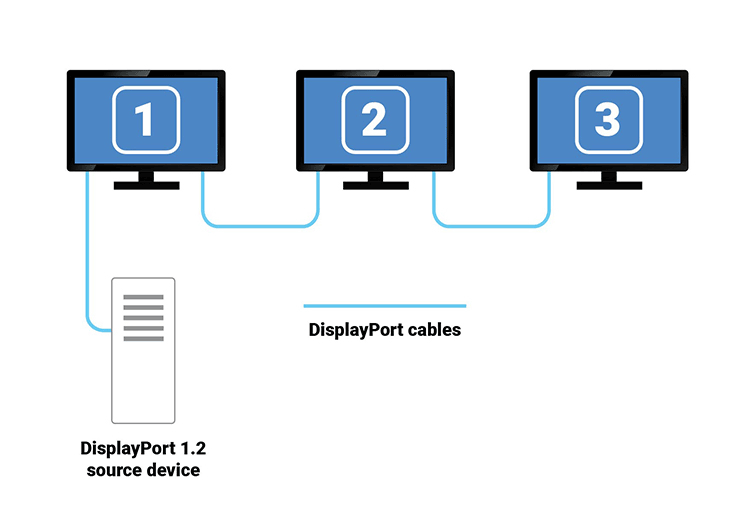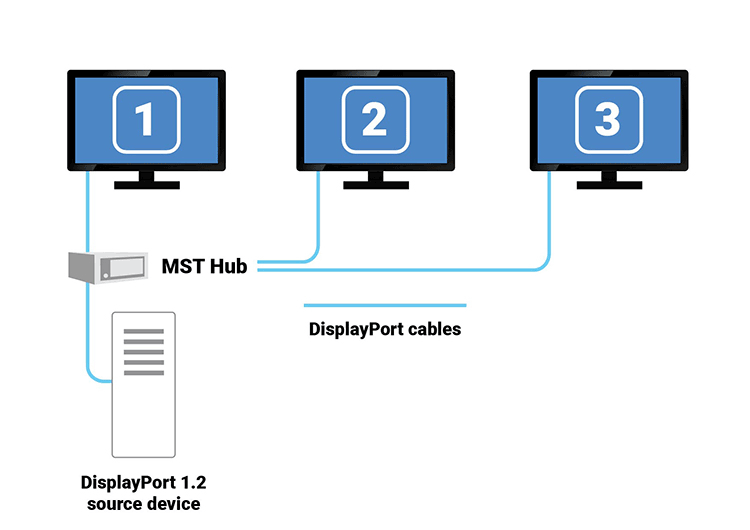Minimalists contend that “less is more.” But when you consider the number of displays you want to connect to your PC or laptop, less is not always more. Increasingly, people want to connect 2, 3, or even 4 additional monitors to one PC or laptop. Businesses, healthcare facilities, transportation hubs, and other industries strive to create tidy computer or digital signage installations that foster increased productivity and seamless multi-tasking, while also providing a better user experience. CAD design and post-production video editing users require access to multiple monitors. Digital signage applications display video walls in airports, hospitals, schools, and other locations.
How can we simplify installation of multiple connected monitors? The answer lies in Multi Stream Transport (MST) technology, which enables a source PC or laptop to display content on additional displays. Using MST, you can duplicate your primary display, extend your display across several monitors, or create a video wall.
Over the past several years, desktop, laptop, and notebook computers and other edge networking devices have gotten smaller. Older devices had space for a variety of connectors, including VGA, DVI, and HDMI, but today’s smaller devices don’t have room for these connectors. Many devices are now manufactured with just one or two DisplayPort or mini DisplayPort connectors. And these DisplayPort 1.2 connectors support MST.
MST technology was first introduced in 2009 by the Video Electronics Standards Association (VESA), and incorporated into the DisplayPort 1.2 standard in 2010. MST gives your DisplayPort 1.2 source monitor the ability to stream independent video displays from a single desktop or notebook video output using just one DisplayPort cable connection. It divides the video signal at the source monitor into several digital signals at the destination monitors. Contrast MST to Single Stream Transport (SST), which transmits video as a single stream of data to one monitor.
Advantages of MST Include:
MST can apply to a variety of applications, including video walls or a group of monitors on a desk. Today’s advanced graphics cards can support multiple video connections via a DisplayPort 1.2 connector. MST is built into the DisplayPort 1.2 standard and supports up to 5 monitors at 1680 x 1050 (WSXGA) resolution, 4 monitors at 1920 x 1080 (1080p) or 1920 x 1200, 2 monitors at 2560 x 1600 (WQXGA), or 1 monitor at 3840 x 2160 (UltraHD, 4K) or 4096 x 2160 (4K x 2K).
There are two types of MST applications. Both configurations enable you to share a DisplayPort or Mini DisplayPort signal with several monitors. The first configuration, daisy chaining, involves connecting monitors in a string (or chain) via a DisplayPort cable. See the illustration below.

The second type of installation uses a hub to connect multiple monitors together, as shown below.

In the two examples above, 3 monitor connections are shown. But MST supports up to 5 monitors at 1680 x 1050 (WSXGA) resolution, 4 monitors at 1920 x 1080 (1080p) or 1920 x 1200, 2 monitors at 2560 x 1600 (WQXGA), or 1 monitor at 3840 x 2160 (UltraHD, 4K) or 4096 x 2160 (4K x 2K).
What You Will Need to Connect Additional DisplayPort 1.2 Monitors Using MST
You will need the following components to deploy MST at your worksite:
Each monitor in the daisy chain or hub configuration needs to have a DisplayPort 1.2 input and a dedicated DisplayPort 1.2 output port, and you need a DisplayPort cable for each connection. But the last monitor in the daisy chain or hub configuration only needs one port, a DisplayPort 1.1 or higher input port.
Today’s KVM extenders support MST on their DisplayPort connectors. For example, the Black Box KVXHP Series extenders reduce the tangle of cables on users’ desktops, and enable flexible, multiple monitor connections. KVM extenders with MST enable single or dual-head 4K/60 video, or even quad-head HD/60 resolutions.
A KVM extender includes a transmitter and a receiver. The transmitter connects to the source PC and carries digital signals and data. These signals extend to the desktop, where the receiver powers the monitors, keyboard, and mouse. A dual-head KVM extender can support up to 2 monitors on the desktop or video wall; a quad-head KVM extender can attach to up to 4 monitors on the desktop or video wall. With DisplayPort 1.2 connectors, the monitors use MST to display content on the destination monitors at high resolutions for a crisp, clear video experience for the user.
Take Advantage of MST over DisplayPort 1.2
Now you know how you can add more monitor connections from one source with MST. This technology minimizes cable clutter in your work area so you can maximize productivity and streamline work methods. MST connects DisplayPort 1.2 monitors together in daisy chain or hub configurations. And MST provides direct source to screens connections. Modern KVM extenders deploy MST so users can view critical data on multiple monitors or a video wall. MST over DisplayPort 1.2 also helps organizations save money on equipment costs and provide an unparalleled user experience.
Ready to deploy MST with KVM? Black Box offers a full line of KVM extenders and cables that use DisplayPort connectors to carry MST signals. For more information, contact us today.